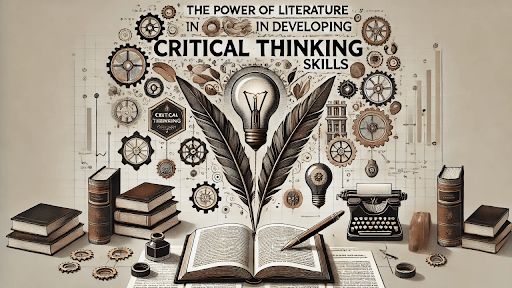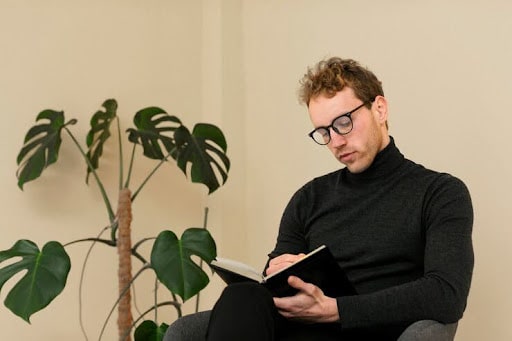It begins with a question. Not just what happens in the story, but why—and how—and what if. Literature has always been more than entertainment; it’s a mental gymnasium, a playground for possibilities, a puzzle box of human experience. You might think it’s just about plot and character. But hidden beneath the surface of every novel, poem, and short story is an invitation to think critically.
In today’s world, where misinformation travels faster than light and opinions are weaponized, developing critical thinking is no longer optional—it’s survival. Literature, quietly and persistently, trains us to think better. No blinking dashboards. No digital flashcards. Just words. Sentences. Ideas.

Image link: https://www.linkedin.com/pulse/power-literature-developing-critical-thinking-skills-lalit-g6wic
The Cognitive Workout Behind Fiction
Let’s be clear: reading a book doesn’t automatically make you a better thinker. But reading deeply? That’s a different matter.
When we read novels online and immerse ourselves in them, we’re engaging in what psychologists call Theory of Mind—the ability to attribute thoughts, desires, and intentions to others. In simple terms, novels online teach us to think in a variety of ways. According to a 2013 study published in Science, reading novels improves performance on tests that measure empathy and emotional intelligence. These could be romance novels or free novels online about romantic relationships between office workers. Just a matter of taste. But wait—there’s more.
Literature challenges us with ambiguity. Not everything is resolved. A protagonist lies—but do we believe them? A narrative flips perspective—so who’s right? These questions, often without tidy answers, activate the prefrontal cortex: the brain’s reasoning engine. Critical thinking thrives on ambiguity.
And here’s a twist: in one classroom study from 2020, students who read and analyzed complex literature showed a 27% increase in critical thinking scores compared to peers who studied expository texts alone. That’s not just a margin—it’s a leap.
Breaking the Fourth Wall of Thought
Now let’s flip the switch: what happens when a reader argues with a book? Not out loud, necessarily, but internally. That subtle act of resistance—of not taking the text at face value—is where critical thinking blooms.
Take Orwell’s 1984. One could simply follow Winston Smith’s journey through a dystopia. Or, one could dig deeper: What does “doublethink” reveal about political language? Is Orwell warning us, mocking us, or doing both? Literature invites—and sometimes demands—analysis, synthesis, evaluation. Those are the big three of Bloom’s taxonomy. They’re also the cornerstones of critical thought.
Reading passively is like watching someone else at the gym. Reading actively is doing the reps. Underlining passages, asking “why did the author do this here?”, or comparing two characters’ moral frameworks—these actions build mental muscles.
Characters: Mirrors and Contradictions
Literary characters aren’t just people. They’re ideas in disguise. You don’t just read free novels online, you’re confronted with hundreds of contradictions and difficult choices. You can find thousands of such characters in Android or iOS novels on FictionMe, but for a more vivid example, think of Hamlet: one man, a hundred contradictions. He acts, then hesitates. He speaks in riddles, then pleads for truth. What do we make of that? We analyze. We ask hard questions. We interrogate motivation.
Students who learn to analyze character development often gain stronger argumentation skills in other areas, including science and debate. Why? Because they’ve learned to build evidence-based interpretations, anticipate counterarguments, and revise their claims. Literature is practise in nuance.
Not every character is likeable. Some are repellent. Some are untrustworthy. And that’s the point. Confronting moral ambiguity in fiction gives us a safer space to sharpen ethical reasoning. You’re not just reading The Stranger—you’re grappling with existentialism.
Literary Devices as Mental Tools
Simile. Metaphor. Irony. Foreshadowing. These aren’t just ornaments. They’re signals, clues, breadcrumbs. To decode them, readers must interpret tone, understand subtext, and sometimes identify what’s not said. It’s a kind of mental forensics.
Consider irony. Recognizing it requires understanding both what is said and what is meant. It’s mental multitasking. Every time a student detects satire or dramatic irony, they’re practising dual processing—holding multiple meanings in mind and making judgments about them.
As students grow familiar with these tools, they begin to see them in news articles, advertisements, speeches. And suddenly, they’re not just reading—they’re discerning.

Image link: https://www.freepik.com/search?ai=excluded&format=search&last_filter=query&last_value=a+man+
From Page to Practice: Real-World Transfer
A key question: does critical thinking in literature transfer to real life?
Yes—if the reader is guided to reflect. A report by the National Endowment for the Arts found that literature-based curriculum integrated with discussion improved students’ analytical writing by 33%. Not only that—students who read fiction regularly scored higher on the SAT writing and reading sections, on average by 24 points.
But more than scores, it’s about decisions. Readers who habitually question motives in stories often become more discerning voters, consumers, and citizens. They’re less likely to accept information at face value and more likely to ask, what’s the source? or what’s the angle?
That’s not just a reading skill. That’s a life skill.
The Discussion Circle Effect
Reading alone is powerful. Reading with others? Transformative.
Literature circles, Socratic seminars, book clubs—these are incubators for critical discourse. When readers disagree respectfully, defend interpretations, revise their views—something profound happens. They stop parroting and start thinking.
In fact, in group settings, literature-based discussions have been shown to improve listening comprehension and critical engagement by as much as 40% over traditional lecture-based instruction, according to a 2017 longitudinal study.
These aren’t just stats. They’re blueprints for reimagining how we teach and think.
Conclusion: Don’t Just Read. Think. Then Read Again.
Literature doesn’t hand you the truth. It hands you a lens. Sometimes cracked. Sometimes warped. But it’s yours to look through.
Whether it’s ancient Greek drama or postmodern flash fiction, every literary work offers a laboratory of thought. The trick? Engage with it. Question it. Wrestle with it. Let it unsettle you.
Because every time you read deeply, you’re not just following a story—you’re rewriting how you think.
And thinking better? That might just be the most radical act of all.
